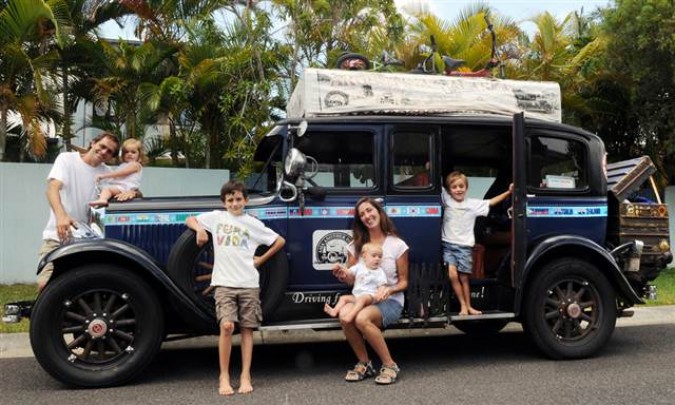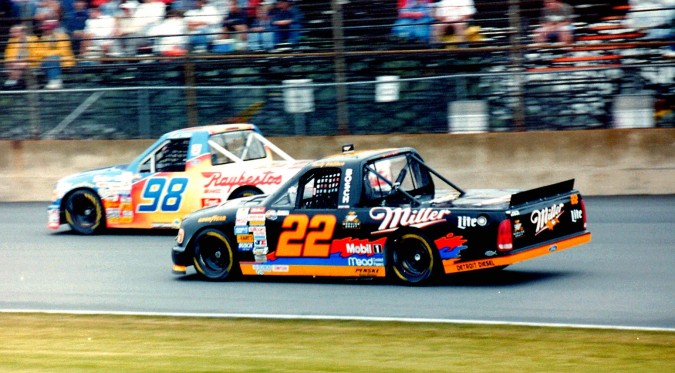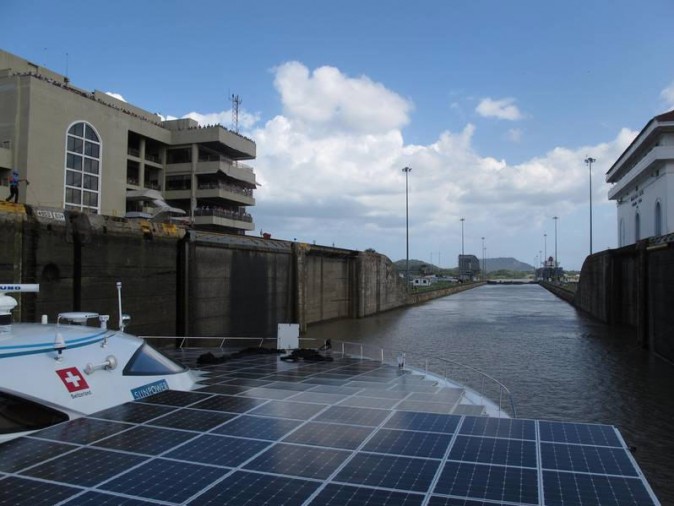Archive for the ‘road trip’ tag
Raising a family in a 1928 automobile while driving 145,000 miles on secondary roads

Herman and Candelaria Zapp with their children, from left: Paloma, 3; Pampa, 8; Wallaby, 1; and Tehue, 5.
I have written about my dream of traveling the world in my bus conversion to promote green living. That might seem a contradiction since such a large vehicle uses a lot of fuel to move. But the dwelling part of the vehicle will likely be the most efficient home many people will have ever seen. I think it’s a fair trade off to burn some fuel to spread the word about how little fuel one can use to live day to day.
Even people who travel the world by plane to spread the word about green living burn a lot of fuel to move those planes around the world.
On a per pound basis, my bus conversion is a lot more efficient than a Toyota Prius. I get 11 miles per gallon on the freeway in my conversion, and the vehicle weighs 28,000 pounds. That is outstanding compared to a set of Prius cars that weigh the same.
Today I want to share a story of an inspirational family lead by Cadelaria and Herman Zapp, pictured above with their four children.
This is not the more famous Hermann Zapf, the legendary typeface designer that created the fluid and beautiful Zapfino font script font.
The Zapp family is traveling the world in a 1928 Detroit-made Graham Paige Model 610 automobile. Herman and Cadelaria started their trip 11 years ago before they had children. They had 4 children during their travels, with each child born in a different country. The map above shows almost the first four years of their travels, which started January 25, 2000. That trip was a mere 43,717 miles long.
So far the Zapps have traveled over 145,000 miles, all on secondary roads as their car is not freeway capable since its top speed is just 40 miles per hour.
The family has made thousands of friends along the way. I just sent a Facebook friend request to Herman Zapp, where he already has 4,671 friends.
The Zapp family includes Herman Zapp, Candelaria Zapp, Paloma Zapp, Pampa Zapp, Wallaby Zapp and Tehue Zapp.
The friends the Zapps make are crucial to the success of their adventure. When their car broke down in Puebla, Mexico, a new friend they made showed them to a nearby car museum. The staff at the museum disassembled one of their cars on display and gave the Zapps the replacement part they needed for their car. That’s right — the museum ruined one of their cars to keep the Zapp’s car on the road. That’s an extraordinary story of kindness.
I would love to meet a woman interested in going on such an adventure with me in my bus conversion. I can easily imagine homeschooling any resulting children and blogging daily about our adventures. I like to write, and I can see writing books about our travels and selling them online, as the Zapps do to make money. I’m a pretty good photographer so I could illustrate the blog and book with thousands of images. Who knows, maybe I might even make some stock photo or stock video income, since I also shoot video.
I plan to grow vegetables and raise fish, chickens and quail on my bus conversion. This may sound crazy, but I’m already growing vegetables and raising fish and chickens in my backyard, and it’s not that difficult. I see no reason except for possible agriculture laws in some locales to keep me from becoming partly food independent during my travels.
The Zapp’s 2007 book about their travels is called Spark Your Dream. As of today it has 30 five star reviews on Amazon. It has 2 four star reviews and zero reviews with fewer than four stars. It promises to be a good book, and I plan to check it out of my library if it’s available.
The Zapp’s have been featured in many newspapers along the way, including on the front page of some. Their website has a great section that shows off scans of the actual papers, most of them not written in English. I have a hard time reading the scans since they’re not at high resolution. I hope they find this blog and rescan the articles at a higher resolution so one can blow them up to read them directly. Right now you can blow them up but they’re fuzzy.
Another recommendation I have for the Zapps is they should post all their photographs at much, much higher resolution. Most of their pictures are tiny. Since what they are doing is so newsworthy, they should make it easy for printed media to publish their travel pictures. A magazine can’t use the tiny pictures the Zapps have on their site currently. I suggest nothing less than 6 megapixels or so.
My brother Andrew Warnock and his wife Krista Warnock homeschool their children. Their kids are the best behaved and most inquisitive I know. Granted, I know few young children, but from my perspective their home schooling is a complete success.
I hope to meet the Zapps one day, and in the meantime, get to know them via Facebook and their website, which is also available in Spanish.
And as for any plans of stopping – “We have driven almost the distance to The Moon from Earth and we aim to keep going,” Mr. Zapp said.
I want to drive my bus conversion around the world to promote green living
Last year I read the book Take your RV to Europe by Adelle and Ron Milavsky. This book was inspiring, for it made me want to take my RTS bus conversion to Europe, and I have been planning this trip now for about a year. Last year I told my entire family about my plans.
The authors of Take your RV to Europe took their Toyota based class C RV to Europe, and now leave it parked there full time so they can fly over and go on extended multi-month voyages as they please without the hassle of shipping the vehicle over for each trip.
I got shipping quotes last year around June of 2010, and the price is about $7,000 each way to take my 40 foot long conversion to The Port of Rotterdam, Netherlands from The Port of Oakland, California, the nearest large ocean shipping port to my house.
My plan has been to spend a solid year traveling and living in the conversion full time. The book makes it clear that Europe is very friendly to recreational vehicles, much more so that is the United States. In most medium and large European cities there are RV parks, unlike in the US. For example, there are large RV parks in London and Paris. The one in Paris is walking distance to a Metro station… just outstanding. There are no RV parks in San Francisco, where I live, one of the most popular tourist destinations in the world… just awful.
Take your RV to Europe makes a strong case that shipping your RV to Europe is the least costly way to travel for an extended time in Europe.
Fuel is costly in Europe, granted, but distances are short compared to the US.
Restaurant food is costly, so being able to cook on board the RV saves a fortune compared to staying in hotels or even youth hostels. I stayed in a couple of different youth hostels in 2009 when I was in Amsterdam, Netherlands, and I recall paying around 40 Euros a night, which really adds up, particularly since you need to buy lunch and dinner on your own. If I were to do an extended tour of Europe, I would hope I had a new girlfriend or wife by then and would be able to bring her along.
While it may be a while before I embark on a European bus conversion adventure, I wanted to share with you my newest variant of my dream, which I am really excited about:
I want to elevate my trip from a mere road trip into a voyage to change the world.
As you know now from my frequent posts about my plans to build many green features into my beloved RTS, I am passionate about living efficiently. While I own a 1,600 square foot house in the center of San Francisco, California USA, I don’t use all that space for just myself. I rent out most of it to my 4 roommates. Divided evenly, that comes to 320 square feet per person, which is close to the area inside my bus conversion.
Most of the inhabitants of the world live in dwellings much smaller than the average US house.
There are many great advantages to choosing to live in smaller dwellings — interest savings, maintenance savings, time savings, energy savings and mental energy savings, for example.
My green bus will be loaded with technology that will showcase how green living can still be richly pleasurable and rewarding. Few people have ever stepped foot in a truly green home, in part because few such homes exist. They certainly don’t exist in every city and town in the US and Europe. But my green RTS can visit such towns and cities with relative ease.
I hope to be able to change the world by showing people my green bus and telling them about it. I am already working hard to develop my journalism skills by building up my audience for this blog at KevinWarnock.com. I am not scared to speak in public, and I’ve been interviewed on the radio before, while I was CEO at Hotpaper.com, my first Internet startup from the first dot com boom in the 1990s.
I envision arriving in a new city or town and parking my green bus conversion right in front of the venue I will be speaking at. There, I will spend the night. I will address the group assembled by my host and then invite the group to tour my green home. Since it will be my actual home for an extended period, it will be believable in a way that I think most model futuristic homes are not, because they don’t look lived in, because they are not lived in.
I will get my start on this public speaking circuit in the San Francisco Bay Area, where there are many receptive audiences for my green messages. As I build my blog readership and get speaking credits, I hope to get more radio interviews and then television interviews.
At this point, when my ideas are getting more attention, I hope that I will be able to recruit sponsors to help me pay for my eventual adventure traveling around Europe, which will cost perhaps $50,000 for the year. I have been thinking of getting sponsors for a while now, but I really decided to try to make it actually happen when I read the inspirational stories at PlanetSolar.org, which describes a solar electrically powered yacht circumnavigating the globe right now to help publicize the potential of solar electricity. The owners of the Planet Solar craft got sponsors to help pay for the project, which probably has a cost surpassing $20 million, since the boat alone reportedly cost $17.5 million. I first learned of the PlanetSolar project in National Geographic magazine, which my roommate Marie had on the dining room table last week. Thank you Marie.
I need to make friends with the Planet Solar team, including Patrick Marchesseau, the ship’s master.
My green bus conversion offers many opportunities for sponsorship. With slide out trays, I could probably fit $20,000 of solar panels on the roof, which would be enough to fully air condition the vehicle on a hot sunny day. For a large house, it might take $200,000 of solar panels to do the same, which is just too expensive for most to even consider. But if people could reduce their living space, all kinds of formerly cost prohibitive technologies become affordable. While $20,000 is still a lot of money, over time it’s not much, considering those solar panels will last for a quarter of a century. Electricity will cost a lot more then than now, so after inflation, the $20,000 really won’t seem like much. Right now I only have $1,000 worth of solar panels on the roof, due to budget constraints.
Buses routinely have billboards on their sides, so sponsors could show off their participation in return for their help. Such ads would help me spread the word as well, as they would draw attention to me and help me start conversations wherever I park.
When I downloaded the picture above of the Planet Solar craft navigating through the Panama Canal, I noticed the SunPower logo on the side. My friend Matt Campbell works at SunPower. Maybe he’ll introduce me to their sponsorship group? Are you reading this Matt?
Once I get sponsors, I would probably have to register my RTS as a commercial vehicle and begin paying commercial vehicle insurance rates. As a side note, I insure my RTS with Progressive Insurance, and I recommend this company.
I want to be perfectly clear that currently I accept no sponsorships and am not running any kind of a business with my RTS. Right now it’s my hobby with no business angle whatsoever. It actually costs me a lot, as you might well guess. Commercial insurance is expensive, so I would love to one day get an insurance company as a sponsor, so they could insure it as part of their sponsorship.
Why would an insurance company care? I suspect that solar panel insurance is going to be big business one day, as having tens of thousands of easily re-sellable and highly durable panels just sitting on a roof makes them a target for thieves.
With the right sponsors, I might one day even upgrade the vehicle drivetrain. It is a bit ridiculous to be advocating super green living while driving a vehicle that gets only 11 miles to the gallon on the freeway. It would be much better to use a modern electric drivetrain, from one of the innovative startups working hard on such things, such as Motiv Power Systems, which recently received a 7 figure government grant to develop electric power-trains for shuttle buses. These drivetrains are expensive for non transit system use, but with a sponsor they could be practical. If my green bus conversion were all electric, I could see getting featured on prime time network and cable television shows in every country I visit. I know the founders at Motiv Power Systems, and they are passionate about their dream to electrify transit buses. I’m not sure their drivetrains are suitable for intracity travel.
Once I tour Europe, I can then see touring Asia and the United States. I don’t plan to tour the US first as I’ve already driven across the US in my bus once, and the distances are so great I fear I would spend more time driving than speaking and showing, which I believe are key to changing perceptions about how much space is needed for a happy life. I also believe audiences in Europe and Asia will be more receptive to my ideas since their residents already live in smaller dwellings and pay much more for energy than residents do in the United States.





